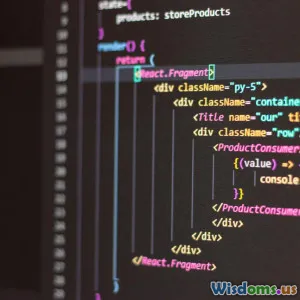
React or Vue Which Frontend Framework Is Best for Your Next Project
8 min read Discover which frontend framework—React or Vue—is truly the best fit for your next project with clear, detailed insights. (0 Reviews)
React or Vue: Which Frontend Framework Is Best for Your Next Project?
In the fast-evolving world of web development, selecting the right frontend framework is paramount for building intuitive and performant user interfaces. Among the myriad of choices, React and Vue stand out as two of the most popular and powerful tools. But which one should you pick for your next project? This question intrigues many developers and project managers alike, as making the right choice can dramatically influence development speed, application maintainability, and scalability.
Let's dive deep into a comprehensive comparison that unpacks the history, core features, community support, learning curve, ecosystem, and real-world use cases of React and Vue. By the end of this article, you’ll be equipped to make a knowledgeable decision tailored to your project’s unique requirements.
Understanding React and Vue: A Brief Overview
What is React?
React, developed and maintained by Facebook since 2013, is a declarative, component-based JavaScript library for building user interfaces. It's celebrated for its efficiency in rendering views with the virtual DOM and its flexible architecture that allows integration with various libraries for routing and state management.
React's ecosystem is vast, offering extensive community support, a wide range of third-party libraries, and corporate backing that fuels continuous evolution and stability.
What is Vue?
Vue.js, created by Evan You in 2014, is a progressive JavaScript framework. It focuses on approachable core features combined with an incrementally adoptable design. Vue is known for being lightweight, straightforward, and seamlessly integrating with other projects. It offers tools like Vue Router and Vuex out of the box, facilitating efficient project structuring.
Unlike React’s corporate backing, Vue thrives through strong community contributions and sponsorship from companies like Alibaba and Xiaomi.
Core Comparison: React vs Vue
To truly analyze which framework suits your project better, it's essential to contrast multiple dimensions.
1. Learning Curve and Developer Experience
Vue's learning curve is often considered gentler for beginners. Its templating syntax is HTML-like, making it more intuitive for those familiar with web fundamentals. The official Vue documentation is succinct, offering examples that accelerate onboarding.
React requires understanding JSX, a syntax extension combining JavaScript and HTML-like structures, which can initially be challenging. Moreover, React’s ecosystem demands developers pick libraries for routing or state management, adding to the learning overhead.
Example: A junior frontend developer might become productive with Vue in days, while React could require weeks familiarizing with its ecosystem.
Evan You (Vue creator) highlights Vue's simplicity and low entry barrier as key advantages for adoption.
2. Flexibility and Ecosystem
React shines with its flexibility. It's just a UI library, providing the freedom to choose your tools—be it Redux for state management or React Router for navigation. This modularity appeals to developers who prefer assembling solutions tailored to their needs.
Vue, being a full-fledged framework, offers all-in-one solutions with its official router and state management (Vuex). This integrated ecosystem simplifies development by providing standardized tools, minimizing decision fatigue.
3. Performance
Performance metrics of both React and Vue are competitive. Vue slightly edges out React in startup times and memory usage, thanks to its optimized reactivity system.
For example, on performance benchmarks like JS Framework Benchmark, Vue’s rendering and updating times often rank marginally better than React’s. However, these differences are negligible in typical applications.
4. Community and Corporate Backing
React boasts a massive community and is maintained by Facebook. Major companies like Airbnb, Netflix, and Instagram have seamlessly scaled React for their applications.
Vue has an enthusiastic and growing community, particularly strong in Asia. Companies like Alibaba and Xiaomi use Vue extensively. Despite lacking a tech giant's continual heavy investment, Vue’s community-driven approach ensures steady progress.
5. Tooling and Scalability
React’s compatibility with numerous third-party tools, like Next.js for server-side rendering (SSR) and testing utilities like Jest, enables builds from small to enterprise-grade applications.
Vue also supports SSR through Nuxt.js, a framework that offers an elegant development experience akin to React's Next.js.
Both frameworks can scale complex applications efficiently, but React’s flexibility might be better suited for highly customized architectures.
Real-World Use Cases and Success Stories
-
React:
- Facebook: The originator of React, utilizing it across its main products.
- Netflix: Transitioned to React for faster startup performance and improved UI modularity.
- Airbnb: Uses React for dynamic user experiences.
-
Vue:
- Alibaba: Employs Vue to power their mobile site and intricate web apps.
- GitLab: Utilizes Vue for frontend to enhance user interface consistency.
- Grammarly: Integrates Vue components for sleek UI features.
These examples illustrate how both React and Vue are battle-tested, capable frameworks that large-scale companies rely on for complex applications.
Final Thoughts: How to Choose the Best Framework for Your Next Project?
Your decision ultimately depends on your project’s requirements, team expertise, and long-term maintenance plans.
Choose React if:
- You desire flexibility and control over architecture/components.
- Your team has experience with JavaScript and JSX.
- You plan to leverage extensive community resources and third-party integrations.
- You are building large-scale or enterprise-grade applications requiring customization.
Choose Vue if:
- You want a gentle learning curve with faster onboarding.
- You prefer an integrated framework with official solutions for routing and state management.
- Your project values simplicity, but seeks high performance.
- You want to quickly prototype or develop maintainable apps with clean syntax.
Both React and Vue represent modern, efficient tools that can power modern web apps excellently. Balancing your project’s unique needs against the strengths and weaknesses discussed will empower you to pick the perfect frontend technology. Ultimately, the “best” framework is the one that aligns with your product goals and developer effectiveness.
References
- React Official Documentation - https://reactjs.org/
- Vue Official Documentation - https://vuejs.org/
- JS Framework Benchmark - https://krausest.github.io/js-framework-benchmark/current.html
- "Why We Migrated to Vue.js" - GitLab Engineering Blog
- Industry Adoption and Surveys by State of JS - https://stateofjs.com/
Explore carefully and choose wisely—your next project deserves nothing less than the best frontend foundation.
Rate the Post
User Reviews
Popular Posts


















